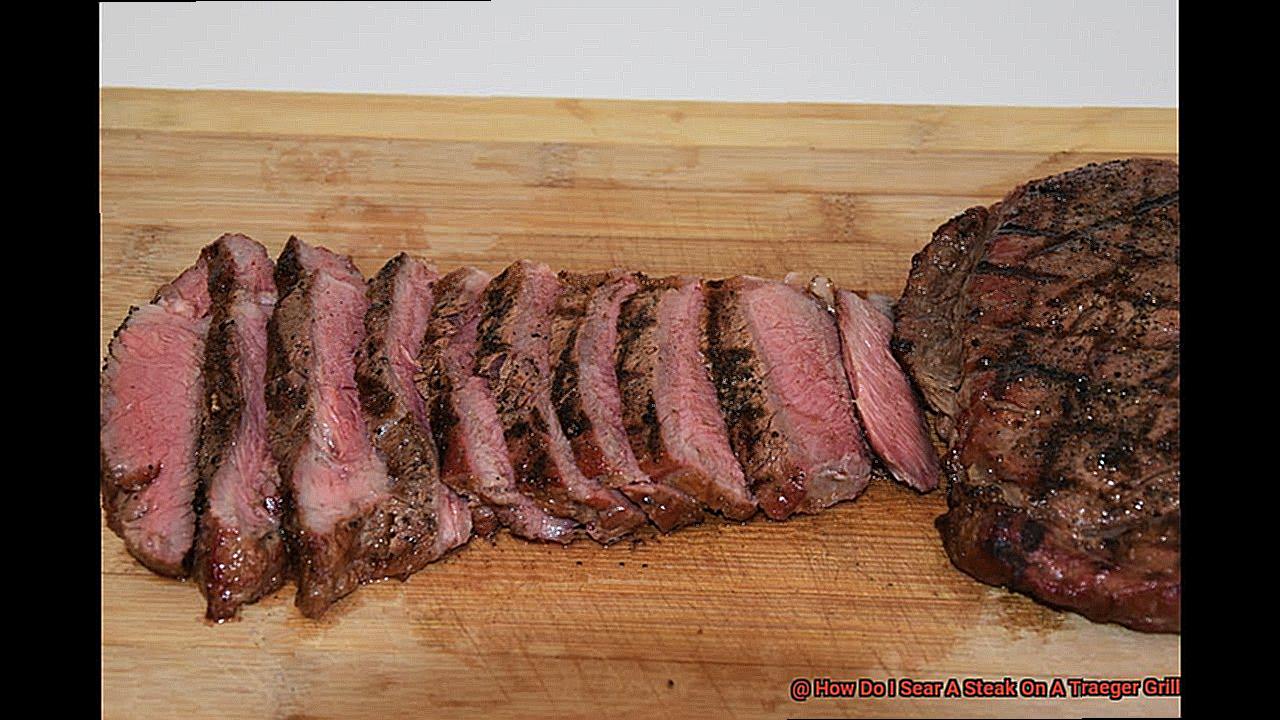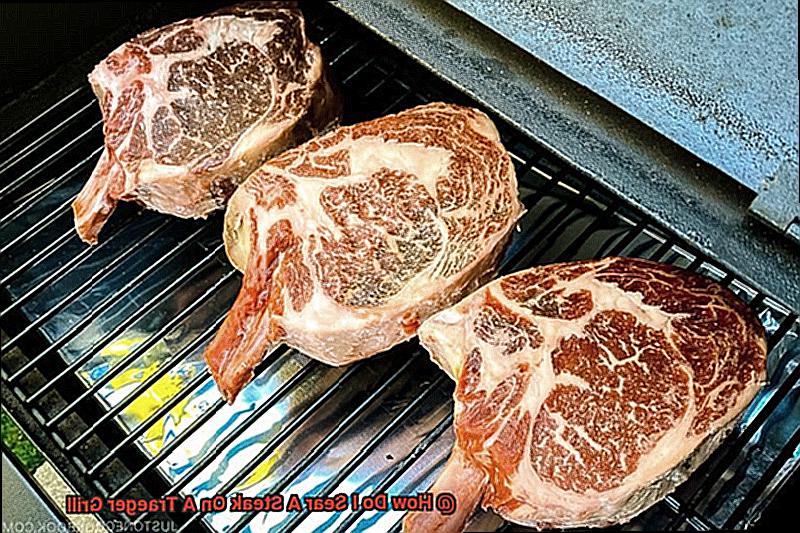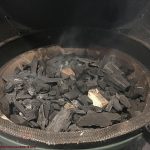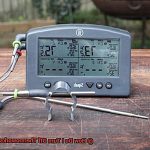Do you crave a juicy, perfectly cooked steak that makes your taste buds dance with joy? Well, it’s time to elevate your grilling game by mastering the art of searing on a Traeger grill. These versatile outdoor cooking machines offer a unique and delicious way to cook steaks that will leave your family and friends begging for more.
Don’t worry if you’ve never seared a steak on a Traeger grill before; we’re here to guide you through the process step-by-step. First things first: choosing the right cut of meat is crucial for achieving optimal flavor and tenderness. We’ll also discuss the benefits of marinating your steak beforehand and how seasoning can take your steak from good to great.
But before we get to the main event, let’s talk about preheating your Traeger grill. This essential step ensures that your steak cooks evenly and at the perfect temperature. Trust us; it’s worth taking an extra few minutes to get this right.
Now for the fun part – searing. We’ll show you how to achieve that beautiful crust on your steak while keeping it tender and juicy on the inside. Plus, we’ll share some tips on avoiding common mistakes like overcooking or under-seasoning.
By now, you’re probably drooling at the thought of sinking your teeth into a perfectly seared Traeger-grilled steak. So what are you waiting for? Fire up that grill, grab your favorite cut of meat, and let’s get cooking.
Contents
What is a Traeger Grill?

If you’re a fan of outdoor cooking, you’ve likely heard of the Traeger grill. But what exactly is it?
In short, the Traeger grill is a versatile outdoor cooking appliance that uses wood pellets as fuel to create heat and smoke that infuses food with a rich flavor. Whether you’re looking to smoke, grill, bake, roast, braise, or barbecue your food, the Traeger grill has got you covered.
Founded by Joe Traeger in 1985, the company has since become one of the leading manufacturers of pellet grills. From compact portable models to large commercial-grade units, there’s a Traeger grill for every outdoor cooking enthusiast.
What sets Traeger grills apart from other types of grills is their unique operating system. The grill has a hopper where wood pellets are stored and an auger that feeds the pellets into a firepot. A digital controller regulates the temperature by adjusting the speed at which the pellets are fed into the firepot. This allows for precise temperature control, making it easy to set and maintain the desired temperature.
One of the standout features of Traeger grills is their ability to sear steaks to perfection. Searing requires high heat, and Traeger grills can reach and maintain temperatures of at least 500°F. Simply preheat your grill to around 450-500°F, season your steak with salt and pepper or your favorite seasoning blend, and let it sear for about 2-3 minutes on each side before reducing the heat to medium and continuing to cook until your desired level of doneness is achieved.
But Traeger grills aren’t just for steaks – they’re perfect for smoking brisket, grilling burgers, roasting vegetables, and more. And with their ease of use and consistent temperature control, they make achieving restaurant-quality results at home a breeze.
Preparing the Steak for Grilling
It’s time to fire up that Traeger grill and get cooking. But before you do, let’s talk about how to prepare the star of the show: the steak.
To ensure a perfectly cooked and delicious steak, it’s important to start with the right cut. The best cuts for grilling are ribeye, sirloin, and T-bone. Make sure your steak is at least one inch thick for proper searing without overcooking the inside.
Now, let’s talk seasoning. While a simple salt and pepper rub will do the trick, why not get creative with other spices or marinades? Just remember to rub the seasoning all over the steak and let it sit for at least 30 minutes before grilling. This will allow the flavors to penetrate the meat and make it more flavorful.
But wait, there’s more. Don’t forget to let that steak come to room temperature before placing it on the grill. Taking a cold steak straight from the fridge to the grill can result in uneven cooking. Letting the steak sit at room temperature for about 30 minutes before grilling will allow it to cook more evenly.
Finally, let’s talk about heat. Preheat your Traeger grill to a blazing 450-500 degrees Fahrenheit before placing the steak on it. This high heat will ensure a good sear and lock in all those delicious juices.
To summarize, here are some key tips for preparing your steak for grilling:
- Choose the right cut (ribeye, sirloin, T-bone)
- Make sure it’s at least one inch thick
- Season with salt and pepper (or get creative with other spices or marinades)
- Let it sit for at least 30 minutes before grilling
- Let it come to room temperature before grilling
- Preheat your Traeger grill to 450-500 degrees Fahrenheit
Preheating the Traeger Grill
Then, listen up, because the secret to achieving that mouth-watering sear lies in preheating your Traeger grill.
Preheating is a crucial step that ensures your grill reaches and maintains the desired temperature throughout the cooking process. It eliminates hot spots and cold spots, resulting in an evenly cooked piece of meat with no unwanted flavors from previous cookings.
To preheat your Traeger grill, start by removing the grill grates and giving them a thorough scrub with a wire brush or scraper. Then, fill up the hopper with your favorite wood pellets, such as hickory or mesquite, and turn on the Traeger to the highest setting.
Let your grill preheat for at least 15 minutes until it reaches a temperature of 450-500°F, but always refer to your manual for specific instructions as this time may vary depending on the size and model of your Traeger grill.
Once your grill has reached the desired temperature, turn it down to medium or medium-high heat, depending on your recipe. Replace the grill grates and let them heat up for an additional 5-10 minutes before placing your steak on them.
Here’s a quick recap of how to preheat your Traeger grill:
- Remove the grill grates and clean them thoroughly.
- Fill up the hopper with wood pellets of your choice.
- Turn on the Traeger to the highest setting and let it preheat for at least 15 minutes until it reaches a temperature of 450-500°F.
- Turn down the heat to medium or medium-high heat.
- Replace the grill grates and let them heat up for an additional 5-10 minutes before placing your steak on them.
Remember that preheating time may vary depending on your Traeger grill’s size and model. Always refer to your manual for specific instructions.
Searing the Steak on the Grill
Look no further than the Traeger grill. Searing a steak on a Traeger grill is a process that requires some technique, but once you master it, your steak will be juicy, flavorful, and downright delicious.
To start, preheat your Traeger grill to high heat for around 10-15 minutes. It’s essential to ensure that the grill is hot enough to create a perfect sear on the steak. While the grill is heating up, season the steak with salt and pepper or any other desired seasonings. Give those taste buds a ride.
Once the grill is hot, place the seasoned steak directly on the grates and let it cook for about 2-3 minutes per side. Don’t flip or move the steak too much during this time as it can prevent a good sear from forming. The initial sear is crucial for achieving that perfect crust on your steak.
After achieving that perfect sear, move the steak to a cooler part of the grill and continue cooking until it reaches your preferred level of doneness. Use a meat thermometer to check the internal temperature of the steak. For medium-rare, aim for an internal temperature of 135°F, while medium should be around 145°F.
Once you’ve achieved your desired level of doneness, remove the steak from the grill and let it rest for a few minutes before slicing into it. This allows the juices to redistribute throughout the meat, resulting in a juicy and flavorful steak.
Monitoring Doneness with a Meat Thermometer
For grill masters, nothing is more important than cooking the perfect steak. Achieving the right level of doneness can be a challenge, but with a meat thermometer in hand, you can become the hero of your next backyard barbecue.
Before grilling, preheat your Traeger grill to high heat and season your steak with your favorite spices. Sear each side for 2-3 minutes to create a perfect crust, then move it to a cooler part of the grill to finish cooking.
But how do you know when it’s done? That’s where the meat thermometer comes in. Insert the thermometer into the thickest part of the steak, making sure it doesn’t touch any bones. Here are some temperature guidelines:
- For medium-rare steaks, aim for an internal temperature of 135°F to 140°F.
- For medium steaks, aim for an internal temperature of 145°F to 150°F.
- For well-done steaks, aim for an internal temperature of 160°F to 165°F.
Remember that the temperature will continue to rise after you remove it from the grill. For a medium-rare steak, remove it from the grill when the thermometer reads around 130°F to 135°F.
Using a meat thermometer may seem like an extra step, but trust us, it’s worth it. No more guessing games or cutting into your steak to check if it’s done – with a meat thermometer, you can ensure that your steak is cooked exactly how you want it every time.
But why stop at just steak? Use your meat thermometer for other dishes too – chicken, pork, and even fish can benefit from precise temperature readings. You’ll never have to worry about undercooked or overcooked meat again.
Adjusting the Heat of the Grill
As any grill master knows, achieving the perfect sear on a steak is essential to impress your guests and satisfy your taste buds. However, adjusting the heat of your Traeger grill can be a daunting task. Fear not, with some expert tips and tricks, you can become a pro at adjusting the heat of your grill and searing steaks like a boss.
First and foremost, it’s crucial to preheat your grill to the highest temperature possible. This ensures that your grill grates are hot enough to create that beautiful crust on your steak. Once your grill is preheated, it’s time to adjust the heat to achieve the perfect sear.
Traeger grills come equipped with a temperature control dial that allows you to adjust the heat easily. For optimal searing, set your Traeger grill to the highest temperature possible, usually around 450-500°F. This creates an ideal environment for achieving that mouth-watering sear on your steak that will leave you and your guests drooling.
Keep in mind, when you’re ready to sear your steak, turn off any “Super Smoke” settings. Though this setting is great for smoking meats, it can make it difficult to achieve a proper sear on your steak. So, make sure to turn it off and let your grill do its thing.
Another critical step is ensuring that your grill grates are clean before starting. Use a wire brush or grill scraper to remove any debris or leftover food from the grates. This eliminates the risk of your steak sticking and guarantees an even sear across the surface of the meat.
Resting After Cooking
But before you dive in, make sure not to overlook the crucial step of letting your steak rest after cooking. Resting your steak is essential to ensure that it retains its moisture and tenderness, resulting in a more enjoyable eating experience.
Why should you let your steak rest? Well, as our research notes state, the steak continues to cook as it rests. By letting it rest for several minutes, you allow the juices to redistribute throughout the meat resulting in a more tender and flavorful steak. Plus, it gives you time to prepare any sides or sauces to go with your perfectly cooked steak.
Resting your steak is easy. Once it’s cooked to perfection, remove it from the grill and place it on a cutting board or plate. Tent it loosely with foil to keep it warm while it rests. The amount of time you should let your steak rest depends on its thickness. Thicker cuts may need up to 15 minutes while thinner cuts can be rested for around 5-10 minutes.
But be patient during this time and avoid cutting into the steak or piercing it with a fork. Doing so will release the juices and result in a dry and tough steak. Instead, cover it with the foil and let it rest undisturbed.
Resting your steak not only results in a better texture but also makes it easier to slice. Cutting into the steak immediately after cooking will cause all the juices to spill out resulting in a dry and unappetizing meal. By allowing your steak to rest, you can serve a delicious and juicy masterpiece that will leave your guests wanting more.
In addition, here are some tips to ensure that your steak is perfectly rested:
- Let your steak rest at room temperature for about 30 minutes before cooking.
- Use a meat thermometer to check if your steak has reached its desired internal temperature before removing it from the grill.
- If you’re cooking multiple steaks, let them rest separately to avoid overcrowding and uneven cooking.
Tips for Perfectly Seared Steaks Every Time
When it comes to achieving perfectly seared steaks on your Traeger grill, there are a few key steps to follow. Let’s dive into each step in more detail to ensure you can create mouthwatering steaks that your guests will rave about.
Step One: Choose the Right Cut of Steak
Before you start grilling, it’s essential to choose the right cut of steak. Look for cuts that are at least one inch thick, such as ribeye or New York strip. Thinner cuts can easily overcook and dry out, resulting in a tough and flavorless steak.
Step Two: Preheat Your Traeger Grill
Preheating your Traeger grill is crucial for creating a crispy exterior while keeping the inside juicy and tender. Aim for a high temperature of around 450-500°F before placing your steak on the grill.
Step Three: Prepare Your Steak
Before placing your steak on the grill, ensure it’s at room temperature by taking it out of the fridge 30 minutes beforehand. Pat it dry with paper towels to remove any excess moisture, which can cause steaming instead of searing. Generously season with salt and pepper or your favorite seasoning blend.
Step Four: Sear Your Steak
When it’s time to start grilling, place the steak directly on the grates and let it cook for 2-3 minutes on each side without moving it. This will allow a beautiful crust to form, resulting in those coveted grill marks.
Step Five: Finish Cooking to Desired Internal Temperature
After searing both sides, move the steak to the cool side of the grill and continue cooking until it reaches your desired level of doneness. Use a meat thermometer to check the internal temperature – Medium Rare: 130-135°F, Medium: 140-145°F, Medium Well: 150-155°F, Well Done: 160°F+.
Step Six: Rest Your Steak
Once your steak has reached the desired internal temperature, remove it from the grill and let it rest for a few minutes before slicing into it. This will allow the juices to redistribute evenly, resulting in a more tender and flavorful steak.
Conclusion
To sum it up, searing a steak on a Traeger grill is a culinary adventure that you won’t regret taking. It’s not as complicated as it may seem, and with the right approach, you can achieve mouthwatering results that will make your taste buds sing. To start, choose a thick cut of meat like ribeye or New York strip to ensure maximum tenderness. Then, season it to your liking and preheat your Traeger grill to around 450-500°F for optimal searing.
Once your grill is heated up, place the steak on the grates and resist the urge to move it for 2-3 minutes per side. This will create those beautiful grill marks that we all love. Use a meat thermometer to check the internal temperature and finish cooking until you reach your desired level of doneness. And don’t forget to let the steak rest for several minutes before slicing into it to allow those delicious juices to distribute evenly.
If you’re feeling adventurous, try experimenting with different seasonings or marinades to enhance the flavor even further. And why stop at steaks? Traeger grills are versatile machines that can be used for smoking brisket or roasting vegetables too. With its precise temperature control and innovative operating system, achieving restaurant-quality results at home has never been easier.






